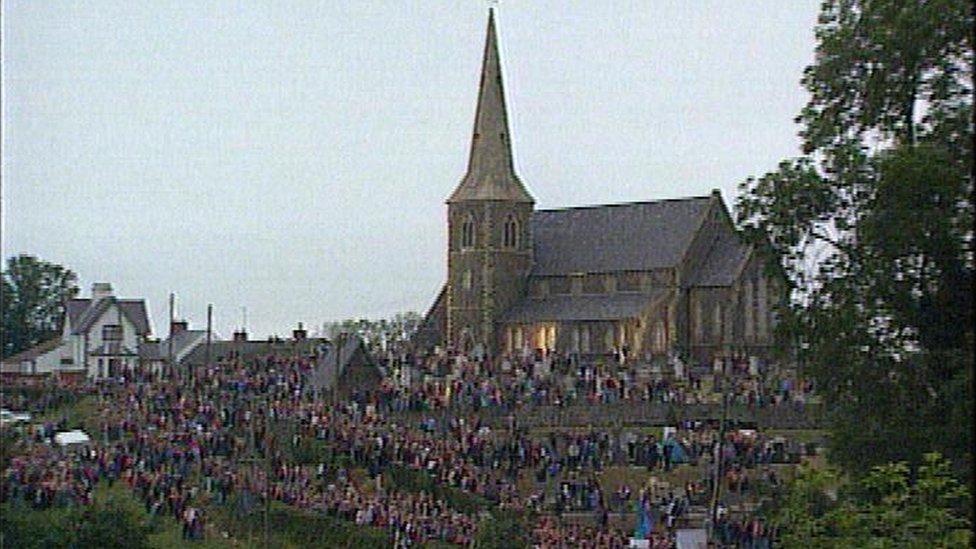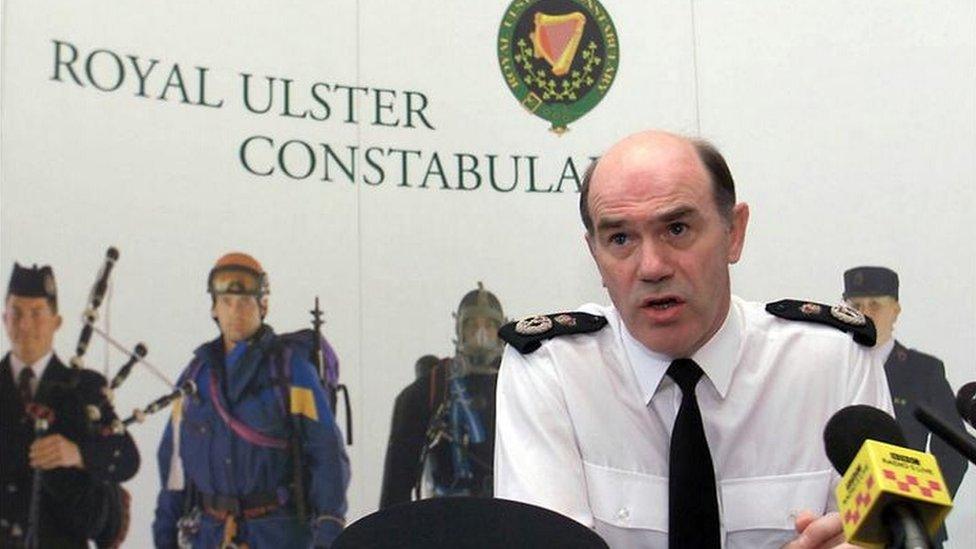State papers: Drumcree crisis of 1996 highlighted
- Published

Confidential state papers shed new light on the serious violence that erupted across Northern Ireland in the summer of 1996, as a result of the failure to find a resolution to the annual Orange Order parade through the nationalist Garvaghy Road to Drumcree parish church in Portadown, County Armagh.
The papers reveal the Northern Ireland Office's efforts under pressure from then Prime Minister John Major, to avert possible serious disorder.
They also disclose detail of the initial decision of the police to ban the Drumcree parade, leading to violent conflict between Orangemen and the Royal Ulster Constabulary (RUC), and the ultimate reversal of that decision that generated major disturbances in nationalist areas.
The Portadown flashpoint was discussed at a meeting between NIO security minister, Sir John Wheeler and then RUC Deputy Chief Constable, Ronnie Flanagan on 17 May 1996.
Flanagan felt that the best solution was one which "allowed honour to both sides".
However, the RUC had to look at the wider picture and "increasing unionist resentment at marches being banned".
Police intelligence, he went on, indicated that a ban on the Orange march down Garvaghy Road that July could result in "a very high number of Orangemen laying siege to Portadown".
This would "create an enormous public order difficulty".
'Statesmanlike'
As regards the influence of then Ulster Unionist leader and Upper Bann MP, David Trimble, Wheeler felt that his controversial role in the previous year's Drumcree situation - when he had joined Rev Ian Paisley in leading the contested Orange parade - "had to be seen in the context of his [UUP] leadership bid".
It was hoped that he could be encouraged to be more "statesmanlike" on this occasion.
But the deputy chief constable said there were rumblings within the Orange Order that Trimble was "going soft by going down to Dublin".
At a meeting with the minister later that day, Trimble voiced concern at the scope for large-scale disorder and accused Sinn Féin of heightening tension.
He suggested a possible compromise whereby the two Drumcree parades of 7 July and 12 July might be reduced to one on a reduced scale.
He favoured dialogue, commenting that "it would be no small event to get the local worshipful master to discuss parades in the local parochial house".
JM Steele, head of security at the NIO, said this "sounded very reasonable".
In the event, however, violence erupted at Drumcree on 7 July 1996 when the RUC banned the parade.
This resulted in a violent confrontation between the police and thousands of loyalists at Drumcree parish church.

Ronnie Flanagan went on to become chief constable of the RUC
As the mob rained stones and bottles on the police lines, the RUC replied with plastic bullets. That night a Catholic taxi driver was shot dead by the UVF near Lurgan.
As violence gripped unionist areas and threatened to bring Northern Ireland to a standstill, the RUC Chief Constable, Sir Hugh Annesley reversed the decision and allowed the march to proceed on 11 July, triggering widespread disturbances in nationalist areas.
'Felt betrayed by RUC'
The crisis dominated a meeting of the NIO's "Committee on the Security Forces and the Community" on 8 August 1996 with the chairman, Mr Perry expressing the view that the turmoil "had resulted in a fundamental change of attitudes towards the RUC across both communities".
For his part, Derek Woods, a civil representative on the ground, reported that support for Sinn Féin had increased since Drumcree "with the party regaining any support lost as a result of the IRA's Manchester bombing [in June]".
The nationalist community "felt betrayed by the RUC over their actions at Drumcree" and IRA recruitment had increased.
He concluded: "Drumcree was, quite simply, a disaster for both communities and their relationship with the police. They were now as far apart as ever."

Police fire plastic bullets at Drumcree in July 1996
A further aspect of the trouble was the boycotting of Protestant businesses by Catholics in counties Tyrone and Fermanagh, followed by tit-for-tat action against Catholic businesses.
It was reported in Newtownstewart, County Tyrone that 30 people had transferred their bank accounts because they had seen their bank manager at Drumcree.
In Castlederg, a diabetic woman had found her pharmacist blocking the road as she went to get her medication; she subsequently changed her chemist.
The crisis led directly to the SDLP's decision to resign its 21 seats in the Northern Ireland Forum, elected in June 1996 as a prelude to all-party talks.
In his resignation letter to John Major, Patsy McGlone, the party's Mid-Ulster representative, asked the PM pointedly: "Who now governs the state as it is more than apparent that major decisions are at the whim of loyalist mob rule and intimidation?"
The Drumcree crisis and the resulting civil disorder resulted in the British government's appointment of the Parades Commission to adjudicate on controversial parades the following year.